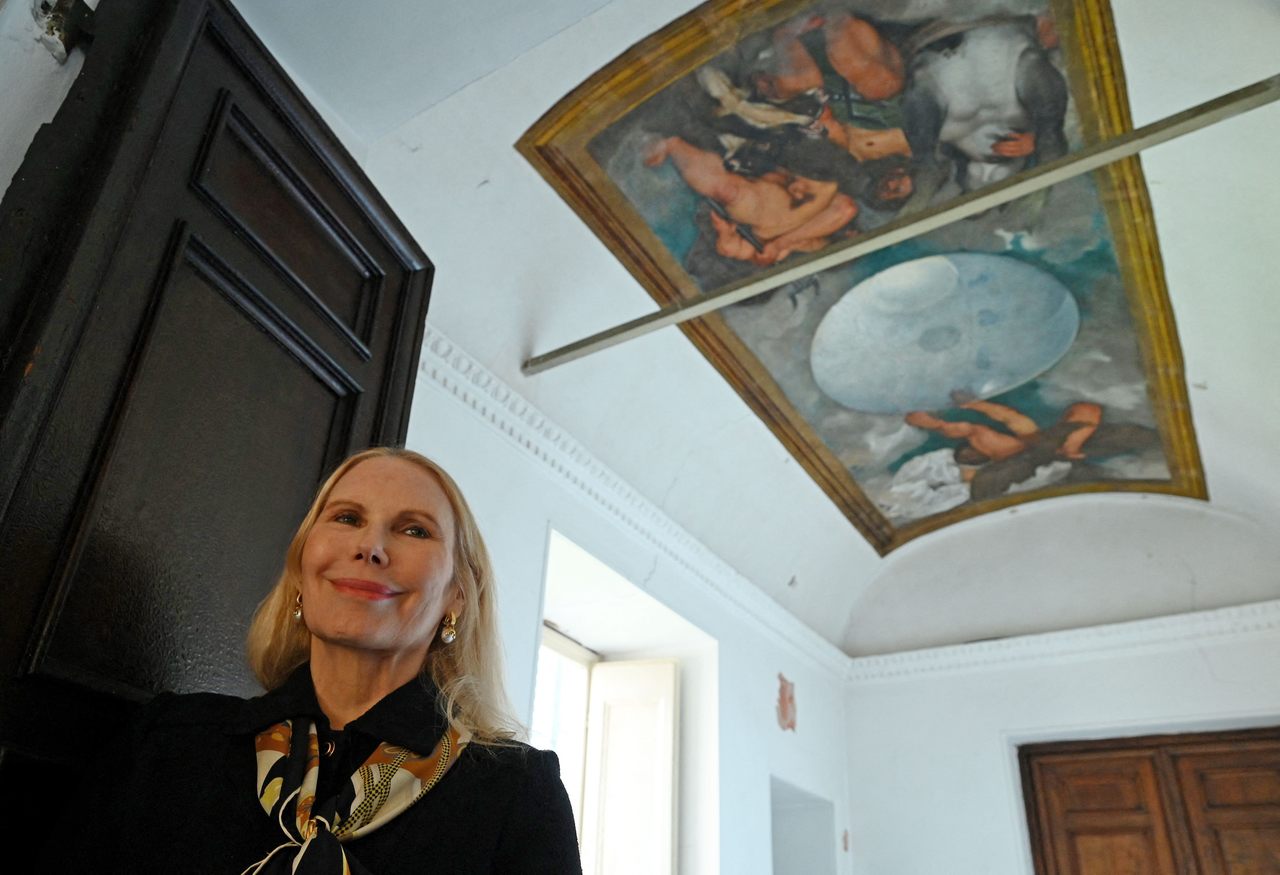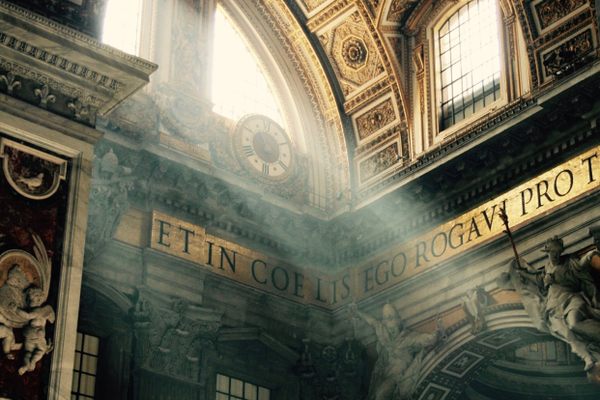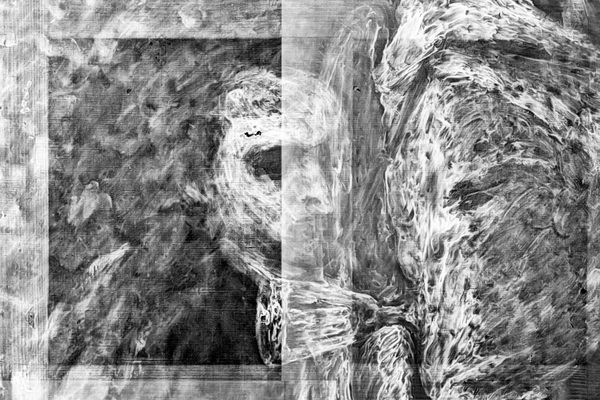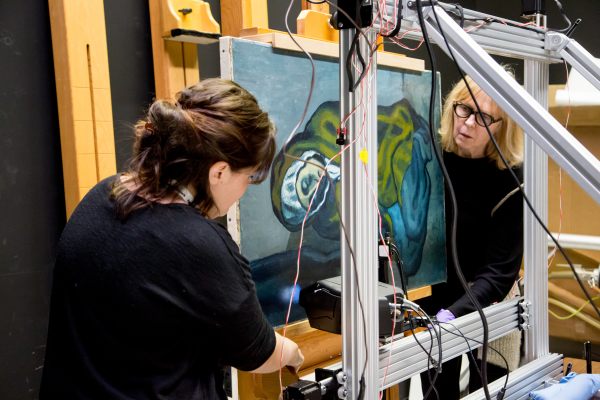A Hidden Caravaggio Masterpiece, An Inheritance Feud, and a Roman Villa up for Sale
The future of a mysterious painting by the famed 17th-century “rebel artist” hangs in the balance.
(Update: According to CNN and other media outlets, earlier this week Princess Rita Boncompagni Ludovisi was evicted from the villa. She told the Associated Press that a book about her years at the villa, and its Caravaggio ceiling, will be published by the end of the year. The future of the villa, and the painting, remain uncertain.)
This story was originally published on The Conversation and appears here under a Creative Commons license.
I teach Italian Renaissance and Baroque art, so when I was visiting Rome in January, how could I not try to see a notorious villa that was up for sale and involved in a nasty inheritance dispute?
The Villa Aurora, named for the masterful fresco by the 17th-century artist Guercino that adorns the ground-floor salon, also happens to house a rare ceiling painting by Caravaggio, the 17th-century “rebel artist,” whose name makes the art market salivate.
I wanted to see the Caravaggio, and not just because its assessed value of US$331 million drove up the estimated price for the villa, apparently scaring off buyers.
Perhaps because of the difficulty in reproducing the work or even viewing it, the Caravaggio has received remarkably little attention from art historians. The villa, which has gone through five failed auctions—the first one asking a cool $502 million—needs maintenance, and Italian law dictates that the Caravaggio and other art cannot be removed.
It is not easy to see privately held art, and given the ongoing controversy, I figured my chances were especially slim. But I duly wrote to the email address I found online.
A week later I got a response, and after some back and forth, on the day before I was to leave Rome, I was invited to come to the villa at 6 p.m. sharp. A woman named Olga met me at the door: “The principessa will be with you in a moment,” she said.

The current inhabitant of the villa is an American-born princess named Rita Boncompagni Ludovisi. A former Texas GOP opposition researcher, she was once married to a congressman caught in the Abscam scandal and posed for Playboy twice in the 1980s. Her second husband, Nicolò Boncampagni Ludovisi, was Prince of Piombino. He owned the villa and promised her usufructuary rights, meaning she should be allowed to occupy the villa until her death.
But the prince’s three sons from his first marriage are forcing the sale because, according to Italian law, inheritances must be divided between the surviving spouse and any descendants. It’s a media story to die for: old-world aristocrats face off against a supposed bimbo and gold digger from Texas—with a Caravaggio thrown in for good measure.
The villa was historically known as the Casino Ludovisi, but it became famous among art historians for its ceiling painting by Guercino. In a tour de force of illusion, the ceiling is painted to look as through the architecture opens up to the sky with the goddess Aurora, or Dawn, driving her chariot across the space above. The Caravaggio, by contrast, barely registers in the voluminous scholarship on the artist.
I looked down in dismay at my sneakers, my corduroy pants, and my purple Eddie Bauer jacket that has seen better days: I hadn’t anticipated meeting the principessa herself.
Olga guided me into a second room and introduced me to the principessa. She is most definitely American – tall, blond and looking much younger than her age of 73. After talking extensively about the villa and its works of art, Rita, as she calls herself, introduced me to a dapper Italian man from the Ministry of Culture, whom, she explained, could hopefully stop her imminent eviction from her home. She then showed me the magnificent painting by Guercino.

Then a journalist from the Italian newspaper La Stampa appeared, and the principessa was whisked away for an interview. She told me, in parting, “Olga will show you the Caravaggio.”
Olga led me up a spiral stairway to the second floor: “Here is the other Guercino,” she said. I looked up to see a second illusionistic fresco, the same size as the one on the ground floor, this one depicting the figure of Fame flying through the sky. I hadn’t known this one even existed.
Then Olga turned on the lights in what looked like a small hallway, its walls painted a bright, hospital white. I looked up to see Caravaggio’s painting, which depicts muscular nude men surrounding a translucent white globe. The detail is intense, the colors bright and sharp in a way that is exceptional for a ceiling painting.
Caravaggio managed to make the three-headed dog Cerberus look as though it really existed, bringing to life the creature’s soft black and white fur, the red of its eyes, the pink ribbing of one upper mouth and the white glint of its teeth.

I later learned that the picture had not been painted in the traditional fresco technique, on wet plaster, but with the unusual application of oil on dry plaster, allowing Caravaggio to execute the precision, color, detail, and texture.
Although some art historians have questioned the attribution, there is no doubt in my mind that this is Caravaggio. Only he would—even could—paint such a seemingly plausible Cerberus.
The composition works only in its original location, since the scale, height and curvature of the ceiling transform the work. The painting purports to show a rectangular opening in the ceiling through which viewers can see the sky and clouds. In the center, within a white globe depicting the universe, one sees the Sun, Moon and signs of the horoscope.
On each side of the globe are the nude, burly he-men: on one side, Jupiter, awkwardly flying through the sky on an eagle, pushes the sphere; on the other, Jupiter’s brothers, Pluto and Neptune, stand as if at the edge of the opening in the ceiling, looking down.
Given its lack of scholarly attention, the Caravaggio is much more compelling than I expected. One 17th-century biographer, Pietro Bellori, claimed that Caravaggio painted the work to silence critics who alleged that he lacked the technical skill to pull off the tricks in perspective required for ceiling art.
But I think Caravaggio was up to something more complicated. His aim was not so much to prove he could paint with foreshortened figures and receding architecture, but rather to make fun of the fad for illusionistic ceiling paintings that render scenes “as if seen from below”—“di sotto in su,” as it is termed in art history.
Running with the concept of “di sotto in su,” Caravaggio cheekily gives onlookers a graphic view from below of Pluto’s penis and testicles, not to mention a novel perspective on his buttocks. Caravaggio didn’t stop there.
Jupiter’s pose is almost incomprehensible, his face concealed, his limbs flailing in different directions—very undignified, particularly for an oversize Olympian god. It’s an NFL linebacker riding an overmatched eagle.
From between Jupiter’s legs emerges the very phallic long neck and beak of the eagle with his bright, dark eye glaring down at the mortals below. (In Italian, “bird” is slang for penis.)

Pluto and Neptune also have their pets, which are themselves rivals: Pluto’s snarling dog frightens Neptune’s seahorse. Neptune, who is Caravaggio’s self-portrait, in turn looks threateningly at Pluto. And then there is the juxtaposition of Cerberus’ bared teeth and Pluto’s very exposed “equipment.”
When I consider the patronage of the painting, it all makes sense. Caravaggio painted the ceiling in 1599 or 1600, when the villa was owned by his first important patron, Cardinal Francesco del Monte. Caravaggio lived in del Monte’s palace in town, and there is evidence to suggest that they both enjoyed the company of young men, and they may even have been lovers.
While it is difficult to confirm the men’s sexual preferences, there is no question that the ceiling is a product of their shared sensibility: locker room art for sophisticated, 17th-century cultural “jocks.”
The room was Del Monte’s “studiolo,” a type of small room usually used by members of the wealthy elite to get away from it all and “study” (whatever that might entail).
The ceiling was to be shared by a bon vivant, learned cardinal with a select audience of like-minded men. Caravaggio never painted another ceiling because tricks of perspective were fundamentally incompatible with his realist inclinations, but perhaps he did this one for his friend and patron as a kind of joke.

I left the Villa Aurora that night with a new perspective on 17th-century art and full of thoughts about the role these works of art, created for members of an extraordinarily privileged elite of the past, play in our modern democratic society.
The same day as my visit, the judge in the inheritance dispute ruled that the principessa would be evicted from the villa to facilitate its sale. I suspect this is devastating for her, given how much effort she has put into preserving her husband’s legacy. But I also wonder what will happen to this villa and its unique collection of 16th- and 17th-century ceiling paintings.
I think it would be a travesty for them to remain in private hands, because everyone, including my students, should be able to see these works. Art historians know about the tensions between private property and cultural heritage, but this is a real opportunity for the new Italian Minister of Culture, Gennaro Sangiuliano, to set an example, as his predecessors have done with the Palazzo Grimani at Santa Formosa in Venice.
Once the residence of a wealthy and powerful noble family, Palazzo Grimani fell into disrepair until it was purchased in 1981 by the state. After many years of renovation, it opened as a public museum in 2008. The frescoes in the Palazzo Grimani are not nearly as artistically significant as those in the Villa Aurora, but the museum today is one of the most interesting monuments in Venice.
I believe the Villa Aurora, restored and open to everyone as a museum of Renaissance and Baroque ceiling painting, could do the same for Rome.
Monika Schmitter is a professor and chair of History of Art and Architecture at UMass Amherst.
This story originally ran in 2023; it has been updated for 2023.








































Follow us on Twitter to get the latest on the world's hidden wonders.
Like us on Facebook to get the latest on the world's hidden wonders.
Follow us on Twitter Like us on Facebook